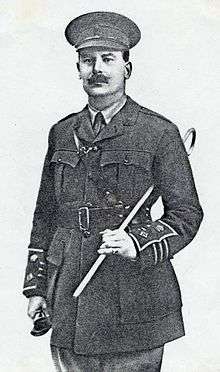Frederick Smith, 2nd Viscount Hambleden


Smith as caricatured by Spy (Leslie Ward) in Vanity Fair, December 1904
William Frederick Danvers Smith, 2nd Viscount Hambleden (12 August 1868 – 16 June 1928), known as Frederick Smith, was an English hereditary peer, businessman and politician.
Life and career
Smith was involved in the management of the family business, W H Smith, which was founded by his grandfather, William Henry Smith. He inherited sole control of the business from his father in 1891 and passed it on to his son.[1]
In 1891, he also succeeded his father William Henry Smith as Member of Parliament for the Strand constituency, holding the seat until January 1910. His rapid succession to the seat his father held in Parliament may have played a role in his being targeted for blackmail by the notorious poisoner Dr. Thomas Neill Cream, who (writing under an assumed name) claimed to have proof that Smith had poisoned a prostitute. This was one of three known attempts at blackmail that may have been the real motive for Cream's string of poisonings in the Stepney and Lambeth areas of London from October 1891 to April 1892. They played a small role in the final arrest, prosecution, and conviction of Cream at the Old Bailey in October 1892, and his execution the following month.[2]
Smith was commissioned Lieutenant in the 2nd Buckinghamshire Rifle Volunteers (Eton College) in 1885, but resigned in 1887. In 1891 he was commissioned Second Lieutenant in the Royal 1st Devon Yeomanry. He was promoted Lieutenant in 1892, Captain in 1895, Major 10 February 1902,[3] and Lieutenant-Colonel in 1914. He served with the Imperial Yeomanry during the Boer War. Smith was made Honorary Colonel of the Royal Devon Yeomanry Artillery in 1922.
He succeeded his mother, Emily Smith, as Viscount Hambleden following her death in 1913. He married Esther Georgiana Caroline nee Gore, a daughter of Arthur Gore, 5th Earl of Arran. Smith was succeeded by their son, William Henry Smith. They had four other children: Edith Mabell Emily (1901–1973), James Frederick Arthur (b. 1906), David John (1907–1976) and Margaret Esther Lucie (1908–1980).[4]
Smith was the main sponsor of the Victoria County History from 1909 until 1931.[5] In May 1902, he was the first person to receive the honorary freedom of the borough of Henley-on-Thames, in recognition of his valuable services to the borough and his munificent donation to the building fund of the new Town hall.[6]
References
- ↑ WH Smith: History
- ↑ Shore, W. Teignmouth: "Thomas Neill Cream", in "Famous Trials 5", Hodge, James H. (ed), Penguin: 1955
- ↑ The London Gazette: no. 27408. p. 1042. 18 February 1902.
- ↑ Lundy, Darryl. "William Frederick Danvers Smith, 2nd Viscount Hambleden", The Peerage, p. 1922, accessed 10 October 2012
- ↑ Lewis, Brian (2008). "William Page (1861–1934), general editor of the Victoria County History 1902–34". Making History.
- ↑ "Mr. W. F. Smith and the Freedom of Henley" The Times (London). Thursday, 1 May 1902. (36756), p. 8.
- Leigh Rayment's Peerage Pages
- Leigh Rayment's Historical List of MPs
- GENUKI/Devon Lord Hambleden and Moretonhampstead
- Bloomfield, Jeffrey The Doctor Wrote Some Letters R. W. Stone, Q.P.M. (ed.) The Criminologist, Winter 1991, Volume 15, Number 4 (p. 224 - 244).
External links
- Hansard 1803–2005: contributions in Parliament by the Viscount Hambleden
- 1903 photo
| Parliament of the United Kingdom | ||
|---|---|---|
| Preceded by William Henry Smith |
Member of Parliament for Strand 1891–1910 |
Succeeded by Walter Long |
| Peerage of the United Kingdom | ||
| Preceded by Emily Smith |
Viscount Hambleden 1913–1928 |
Succeeded by William Smith |